Mist eliminators separate mist from a gas stream to recover valuable products, improve emissions, protect downstream equipment, and improve product purity. This picture shows fiber-bed mist eliminators.
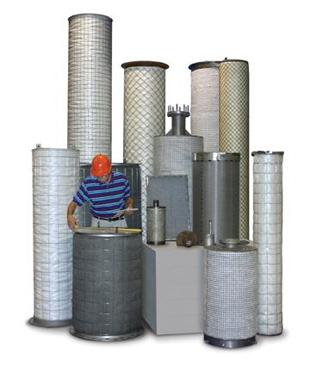
Wire-Mesh
Wire-mesh mist eliminators are by far the most common. Knitted wire mesh pads remove entrained liquid droplets from gas streams.
General Information
Wire-mesh mist eliminators, such as the one shown here, are made of knitted metal mesh. Wire-mesh is the most commonly used method to remove entrained liquid drops down to 3mm in diameter from a gas stream with velocities above 1 ft/s. Wire-mesh pads are most often used in vertical flows, but may also be used horizontally.
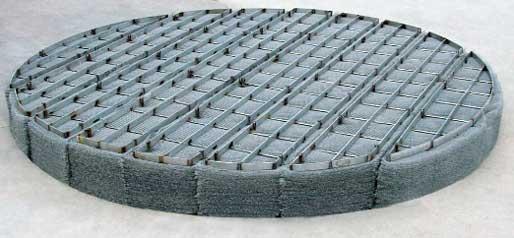
The popularity of wire-mesh mist eliminators is due to their efficiency, modest pressure drop, and low capital and operating costs.
Equipment Design
Impingement mist eliminators remove liquid droplets from a gas stream by three methods: inertial impaction, direct interception, and Brownian diffusion. All three require the mist to contact the wire mesh surface, where liquid droplets are separated from the gas stream and collected, as shown in the animation.
(Animation based on schematic courtesy of Amistco Separation Products Inc., Alvin, TX)
The mesh is made of woven metal fibers. Sheets of mesh are usually layered on top of one another to give greater control of permeability. The picture on the left shows a coiled wire mesh that is held together by the top and bottom support grids. On the right, four mist eliminators are shown.
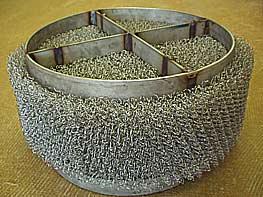

A typical mesh pad is about six inches thick. Diameters are typically three to five percent larger than the equipment diameter, to reduce the amount of mist bypassing the pad.
Usage Examples
Wire-mesh mist eliminators are most commonly found in gas-liquid contacting towers. The fume hoods pictured below contain mesh pad mist eliminators and are used to remove 99% of mists down to 2 microns.
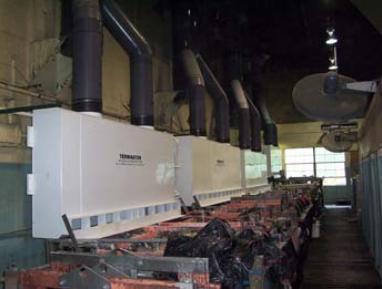
Advantages
- Excellent efficiency.
- Inexpensive to purchase and operate.
- Can be installed on existing equipment.
- Pads can be designed to provide specific efficiencies.
Disadvantages
- Produce a larger pressure drop than baffle-type.
- Not effective for droplets smaller than 3mm in diameter.
- Efficiency drops as droplet size increases.
- Pad may clog.
Fiber-Bed
Fiber-bed mist eliminators consist of columns of fibrous material that remove mist from a gas stream as it passes through them.

General Information
Fiber-bed mist eliminators remove very fine droplets of liquid entrained in a gas stream. They are popular because they are extremely efficient for large liquid flowrates and to remove droplets smaller than 3mm in diameter. However, fiber beds are limited to gas flow rates between 3 to 10 m/min and they cause high-pressure drops.
Fiber-bed mist eliminators are designed for horizontal, concurrent gas stream flow through the bed, never for upward gas flow.

Equipment Design
Fiber-beds remove liquid droplets by forcing contact with the fibrous materials through the same methods as wire-mesh mist eliminators; inertial impaction, direct interception, or diffusion.
The vent system shown here has two fiber beds that take input air containing mist, remove and collect the liquid, then force the clean exhaust out. The collected liquid is drained and may be used for various purposes, depending on the nature of the collected substance.
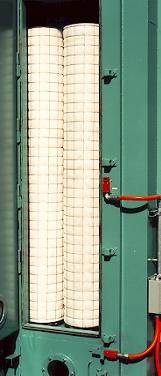
This animation shows a typical fiber-bed mist eliminator with two fiber beds working in conjunction. The gas stream (grey) is forced between the two fiber bed cylinders. When the liquid droplets (blue) hit the fibers, they are separated from the gas and drop to the bottom of the cylinder, where they are collected
(Animation based on schematic by MECS, Inc., Chesterfield, MO)
Cylindrical fiber-beds, such as the one pictured below, are the most common design. The beds are made of two concentric cylindrical screens with a top flange and a bottom drain plate. The mist eliminator pictured below is used in sulfuric acid plants.
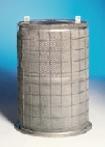
The fibers are made of glass, plastic, ceramic, loose metal fibers, or roped metal. They are usually packed two to three inches thick between a screen framework made of metal or reinforced plastic, called the fiber-bed cage.
Usage Examples
Fiber beds are used to remove very fine mists. Often these occur from shock-cooling of a condensable vapor, such as acid mists created in absorbing towers and oil mists created in various processes. Fiber-bed mist eliminators are used for acid mist removal, such as at the sulfuric acid plant pictured below.
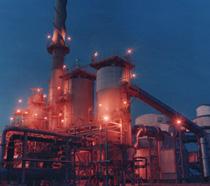
Advantages
- Can remove droplets smaller than 3 micrometers in diameter.
- Efficiencies of 95 to 99.9% can be achieved.
- Large contacting surface allows removal of high volumes of liquid.
Disadvantages
- Large pressure drop.
- Can only handle vapor flow rates below 10 m/min.
- Poor drainage causes clogging.
- Cannot be used for vertical gas flow.
Baffle-Type
Baffle-type, also known as chevron or vane, mist eliminators change the direction of the gas flow in an attempt to force liquid droplets to collect on the baffle surface. The pictures below show baffle-type mist eliminators.


(Copyright Amistco Separation Products Inc., Alvin, TX)
General Information
Baffle-type mist eliminators are useful for both vertical and horizontal gas flows. Little pressure drop occurs from baffle-type mist eliminators, making them popular for processes in which pressure loss must be kept to a minimum. However, baffle-type mist eliminators are only effective for droplets larger than 3 micrometers in diameter and for velocities above 500 ft/min.

Equipment Design
Baffle-type mist eliminators force the gas stream to change direction, resulting in the droplets contacting a surface and being collected by the same mechanisms as wire-mesh mist eliminators; inertial impaction, direct impaction, or diffusion. Baffle-type mist eliminators are not as efficient at collecting very small droplets but cause little pressure drop.
Baffle-type mist eliminators are most commonly used for horizontal gas flows with high flow rates. They are the best choice when the entrained liquid contains undissolved solids.

The contacting surface may be in the form of louvers or blades. Louver-type baffle mist eliminators consist of between three and six rows of blades at angles of 30° to 60° to the flow. They are widely used in cooling towers. Louver baffles are easy to fabricate and have high capacities but are ineffective for droplets smaller than 20mm in diameter.

Blade-type mist eliminators are typically made of one row of baffles with half an inch to three inches between blades. The blade spacing controls the amount of mist collected: Smaller blade spacing increases mist removal, but also increases manufacturing costs and pressure drop. The blades are six to twelve inches deep in the direction of gas flow.
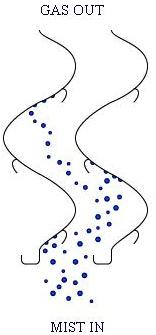
Usage Examples
Baffle-type mist eliminators, especially louver-types, are common in cooling towers, pictured here, where they remove water from the air escaping the tower.
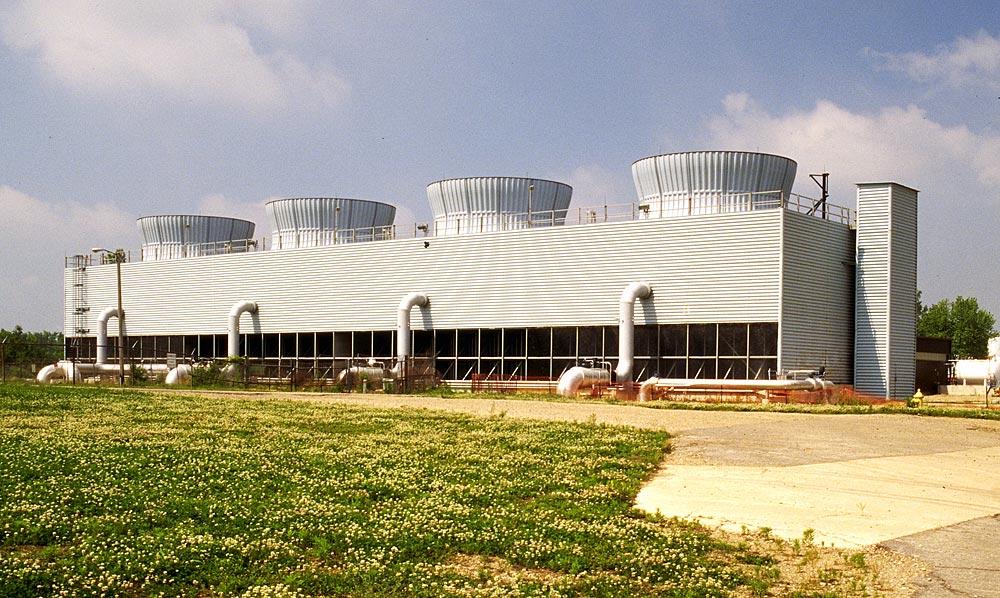
Advantages
- Very low-pressure drop.
- No clogging, useful for streams with entrained solids.
- Blade spacing can be manipulated to yield desired results.
- Easy to fabricate.
- High capacity.
Disadvantages
- Cannot remove droplets smaller than 3mm in diameter.
- Gas stream velocity must be controlled to avoid re-entrainment.
Acknowledgements
- Amistco Separation Products Inc., Alvin, TX
- Jaeger Products, Houston, TX
- Midwest Air Products Co., Inc., Traverse City, MI
- MECS, Inc., Chesterfield, MO
- SPX Cooling Technologies, Overland Park, KS
References
- Brunazzi, Elisabetta and Alessandro Paglianti. “Design of Wire Mesh Mist Eliminators.” AIChE Journal March 1998: 505-512. Print.
- Capps, Ronald W. “Properly Specify Wire-Mesh Mist Eliminators.” Chemical Engineering Progress Dec. 1994: 49-55. Print.
- Fabian, Paul, and Roger Cusack. “Demystifying The Selection of Mist Eliminators: Part 1.” Chemical Engineering Nov. 1993: 148-156. Print.
- Fabian, Paul, and Roger Cusack. “Demystifying The Selection of Mist Eliminators: Part 2.” Chemical Engineering Dec. 1993: 106-111. Print.
- McKetta, John J. “Mist Removal Equipment, Design, and Selection.” Encyclopedia of Chemical Processing and Design. 1st ed. 1989. Print.
Developers
- Daniel Viaches
- Christy Charlton
- Steve Wesorick
- Kelsey Kaplan
